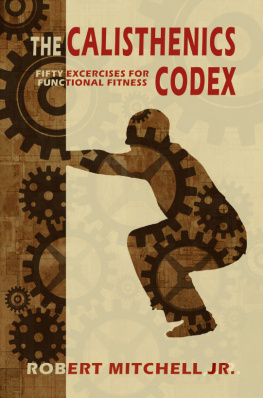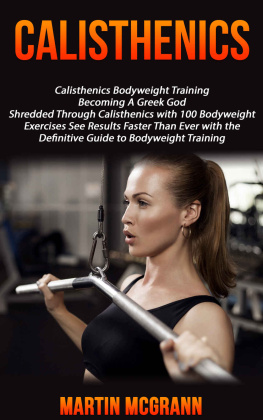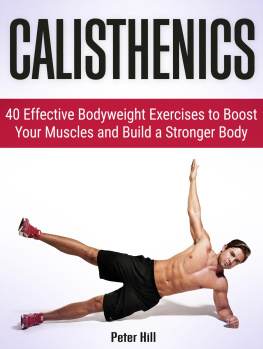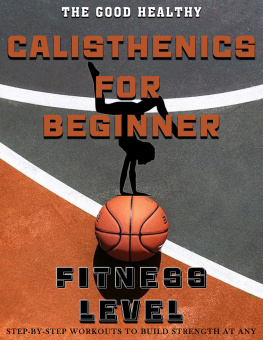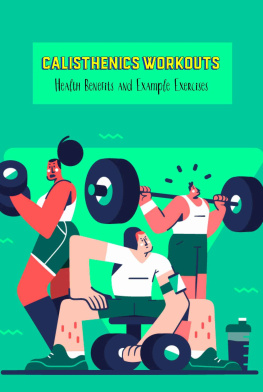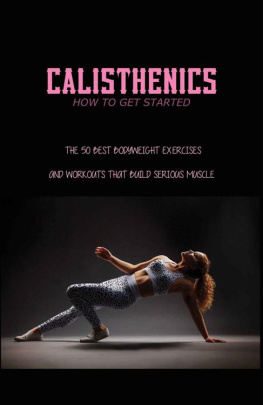The Calisthenics Codex:
Fifty Exercises for
Functional Fitness
Robert Mitchell Jr.
Mitchell, Robert Jr.
The Calisthenics Codex: Fifty Exercises for Functional Fitness
Second edition
Published at Smashwords.com
Copyright 2015, 2021
All rights reserved. No part of this book may bereproduced in any form, except by critics wishing to quote briefpassages in connection with a review.
Thank you for downloading this eBook. Your supportand respect for the property of this author is appreciated.
Visit the authors blog at HERITAGE ARTS,INC.
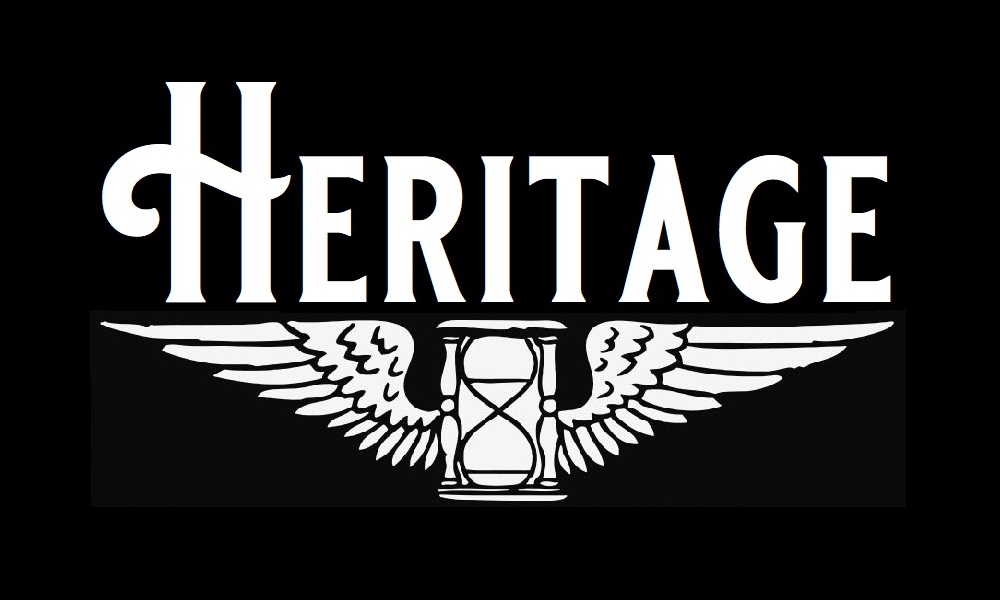
Table of Contents
DISCLAIMER
The author and publisher make norepresentation or warranties with respect to the safety, accuracy,applicability, suitability, or completeness of the contents of thisbook. It is for educational purposes only.
The author and publisher disclaim anywarranties express or implied, and shall in no event be held liableto any party for any direct, indirect, punitive, special,incidental or other consequential damages arising directly orindirectly from any use of this material, which is provided asis, and without warranties.
As always, see your doctor before beginningany fitness regimen.
Author and publisher are not responsible forinjuries associated with the exercises, workout regimens, or othermaterial presented.
1. Introduction andFAQ
Calisthenics are as old as civilization. Inthe course of researching this book I found evidence ofcalisthenics practice in ancient Egypt, Greece, India, theCaucasus, and the Far East. What I learned is that at some point itin the distant past it became clear to the human race that if youwanted to excel at a physical activity of one kind or another --whether it be war, wrestling, dance, or what-have-you -- it wasbeneficial to push past the demands of the activity itself duringpractice.
Thousands of years old and still goingstrong, calisthenics are here to stay. And for good reason:
* You get fit.
* You dont need a gym.
* You dont need equipment.
The end result is a workout regimen thatseffective, cheap, and versatile.
What are Calisthenics?
When you want a definition youre supposedto look in a dictionary, so thats what I did. A dictionary I founddated 1909 defined calisthenics as gymnastics for girls. That onewas clearly out of line, not just with my idea of what calisthenicsare, but with modern ideas of both gender equality and commonusage! I searched high and low and I couldnt find anything thatwas brief and made sense. So I hope you dont mind that I brokewith the traditional dictionary definition and made up my own:
Calisthenics are repetitive exercises, donemore or less in place, requiring no equipment.
Nowadays there is a tendency to classifyexercises like Pull-ups, Rope Climbs, and Flying Rings ascalisthenics. To my mind, exercises of that nature are moreaccurately filed under Gymnastics. Whats great aboutcalisthenics as Ive defined them is that they fill the voidbetween aerobic exercises like running (not done in place) orjumping rope (equipment required), gymnastics (specializedequipment required) and anaerobic exercises like lifting weights(heavy equipment required). If youve ever done calisthenics youknow that they reside in a wonderful little world of exhaustion alltheir own.
And theyre free. You dont need a gymmembership and you dont need to go shopping. All you need is yourbodyweight, and all you need to do is start moving it in order toget in shape.
Hold on, you forgot...
Maybe you think I forgot an exercise? Maybe,but I doubt it. If its a calisthenics exercise theres a highlikelihood Ive done it or at least seen it in a book or online.Whatever it is youre thinking of, I most likely left it out onpurpose. Some were left out because they dont fit the abovedefinition, some because theyre so similar to another exercisethat they arent worthy of mention, others because they carry ahigh injury risk and/or should be taught by a coach (likeSingle-leg Squats a.k.a. Pistols). If you remember my definitionof a Calisthenics exercise (A repetitive exercise, done more orless in place, requiring no equipment) and keep in mind that thisbook isnt for Olympic gymnasts, youll understand why I left outthe one youre thinking of.
Now then -- if you dont have any furtherquestions or comments, can we move on to the material please?
2. How to Use thisBook
This book is menu driven.If you follow my instructions, youll be able to minimize yourinjury risk and construct millions of different workouts. There are2,118,760 possible Bad Karma workouts alone (for the math geeks out there, theformula is 50!/(5!*45!)=2,118,760).
Where do I start?
Its simple. Heres what you do:
1. See your doctor. Show him this book and ask himif its okay for you to take up this program.
2. Read the section on warming up,cooling down, and stretching. Always follow these instructionsbefore and after your Calisthenics workout. No exceptions.
3. Evaluate your fitness level and start at one ofthe three levels: Beginner, Intermediate, or Advanced (see theFitness Evaluation Table below). Wherever you start in the program,make sure that you do not advance more quickly than you should.Plan to spend at least ninety (90) days at each level before goingto the next. Muscles get stronger three (3) times faster thantendons and ligaments -- push too hard and you will blowsomething!
4. Turn to the appropriate chapter based on yourfitness level and pick a workout youd like to try. Selectexercises from one of the lists (there are dozens) or pull from themaster list for your fitness level. Follow the instructions. Listento your body, monitor your heart rate, and do not overdo.
5. If you dont know how to perform an exercise,look up the instructions in The Codex at the back of this book.
6. Do the workouts.
7. Get fit.
Fitness Evaluation Table

What are those numbers I see in brackets after eachexercise?
Actually those arentbrackets, theyre parentheses, but lets not quibble. Those are thetarget repetitions for the exercise in question. For example, whenyou see Push-ups, knuckle (40) it means that the target reps are forty(40).
The numbers are tailoredthe applicable fitness level. For example, note that the targetreps are the same for both Push-ups,knuckle (40) and Push-ups, knuckle on knees (40).Although doing them on your knees is far easier, Push-ups, knuckle on knees are an Intermediate exercise while Push-ups, knuckle are Advanced. Inother words, it should be just about as hard for a person at theAdvanced level to do forty (40) regular Knuckle Push-ups as it isfor an Intermediate level person to do forty (40) onknees.
When you play down from your fitness level-- lets say your fitness level is Advanced and youre doingknuckle Push-ups on your knees which is an Intermediate exercise --you should aim to do more than forty (40).
But the target numbers are only a generalgauge, a starting point if you will. Dont get overly obsessed withthem. Do as many or as few as you like. Just make sure that yourelistening to your body and not overdoing it.
You keep saying that I should avoidoverdoing it and that I should listen to my body. What doesthat mean?
The best way to answer this is with astory.
I had never been able to do more than ten(10) Pull-ups. So, middle-aged and fed up, I decided it was pasttime for me to buckle down and make progress. So I went and got atwenty (20) pound weighted vest, put it on, and started doingPull-ups. Three times a week I would strut up the bar and do eight(8) sets of eight (8) for a total of sixty-four (64) reps. When Ireached failure and could do no more (at first that was halfwaythrough the first set!) I would do the rest of them eccentrically-- that is, I would jump up to the bar and let myself down asslowly as possible. In just two months I had progressed to four (4)sets of eight (8) before having to do the remainder eccentrically.Without the vest I could do twenty clean Pull-ups. Success!
Next page
